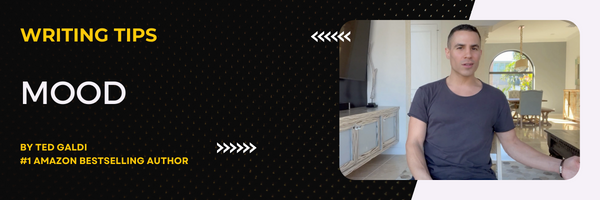Creating an Immersive Mood in Your Story: Examples and TipsIf you're writing a book, screenplay, or short story, you want to create an immersive experience for your reader. You want to pull the audience into your scenes and deliver strong emotional payoffs. Mood is a powerful literary device than can help you do that. In this article, I tell you what a mood in storytelling is, provide examples, and offer tips. Want to write an awesome story? Download my FREE outlining guide. What is mood in writing?Mood in writing is the overall feeling of a scene. Exciting, lighthearted, and somber are examples of moods. A story can have multiple moods, as different scenes can evoke different emotional responses from the audience. The importance of mood in storytellingThe four key elements of a story are character, plot, theme, and emotional impact. Since mood is based on feeling, it's a great tool for enhancing the emotional impact of your story. Each scene should have a distinct mood that's tied into its central conflict. Is your main character running from a serial killer? Fear would be a natural mood for that scene. If you can play up the feeling of fear, you can evoke a strong emotional reaction from your audience. Pulses will go up as they turn the pages. On the other hand, if the mood you're creating doesn't fit with the central conflict of your scene, you can ruin what might be an otherwise great scene. For example, let's say you're writing a scene where the main character just finds out his sister is missing. A mood of anxiety would be a natural fit. However, if you instead gave the scene a detached feel, where the main character doesn't care much, the audience wouldn't care much either. It would feel flat. How mood relates to tone and genre in writingTone is another literary tactic. It refers to the attitude a writer takes toward the events in a story. Unlike mood, which can show up in a different form in various scenes, a story should have just one tone. Examples of tone would be sarcastic, serious, or nostalgic. The tone you choose for your story narrows the moods you can pull off in it. For example, if your story has a sarcastic tone, a somber scene may be difficult to make workable. If, instead, your story had a serious tone, a somber scene would be a natural fit. The genre you write in shouldn't necessarily limit the mood of any scene, however, in totality, the moods of your scenes should align with audience expectations for your genre. For example, if you're writing a horror story, you absolutely can have a scene with a funny mood. Possibly, toward the beginning of the story, before the killer is loose, you can characterize your protagonist by showing her joking around with her friends. However, if your story goes to have 50 scenes total, and 40 of them wind up having a funny mood, your story won't feel like a horror one. Horror readers expect moods like fear, worry, and excitement in the majority of their scenes. Thus, be mindful of mood expectations in your genre. Feel free to go in different directions, but only in small doses. How to create a mood in storytellingThe characters in your scene are the conduits for creating a mood for your audience. What the characters feel directly impacts what your audience feels. Thus, to create a mood, you want to capture the emotional state of your characters. Here are three tips: #1 Create mood with dialogueDialogue is what your characters say to each other. How the characters feel should be reflected in how they talk (even if they're lying, ie subtext). For instance, let's say one character in a scene is training another for a boxing match. While the trainer yells at the boxer, the dialogue would create a mood of intensity. Or maybe you have a scene where one character is warning others about a terrible storm blowing into town. As the characters worry about the storm, an overall mood of worry will emerge. #2 Create mood with settingWith an effective setting, you can create a mood without your characters even speaking. Let's say you're writing a sci-fi story. Your protagonist, who's from Earth, winds up traveling to a different planet. This planet is technologically about 10,000 years ahead of Earth. When your character first arrives and marvels at all the high-tech infrastructure, a mood of awe will be produced. Your character doesn't need to say she's in awe. The setting alone will get the point across. #3 Create mood with plot eventsPlot events should unfold in a cause-and-effect way, with scenes building off one another. Thus, if your main character appears in scene C, the audience may already have a good idea of what's at stake because of previous scenes A and B. For instance, let's say your protagonist, from Nebraska, has been practicing for a singing competition in Los Angeles. If a scene opens with a plane landing in Los Angeles, a feeling of anticipation would be created. Based on past events, the audience knows the high stakes of the LA trip. Though scenes should follow a cause-and-effect flow, they absolutely can be filled with surprises. A surprise is an abrupt plot event that characters did not see coming. Surprise has the ability to create a strong mood in an instant. For instance, let's say you're writing a scene where two couples are enjoying a beach vacation. The scene has a lighthearted mood. Then, a woman discovers a dead body behind a bush. The mood of the next scene immediately becomes panic. The simple reveal of a dead body is all that was needed to produce this strong mood. Build on the mood you createIf you're able to create a distinct mood for a scene, you're off to a good start. Next, you want to build on this mood, ratcheting up its emotional force. Let's go back to the example of a character running from a serial killer. We've established a mood of fear. How can we escalate the feeling of fear? Here's a possible sequence of events that could accomplish this:
What genres use mood?Mood is used across fiction and narrative non-fiction. Some examples of genres that use mood:
Want even more writing tips?
0 Comments
Leave a Reply. |


 RSS Feed
RSS Feed